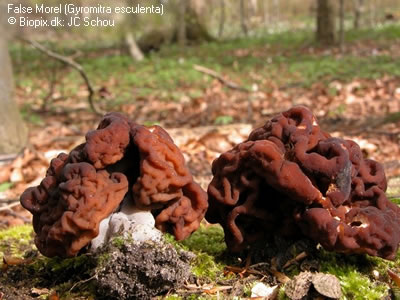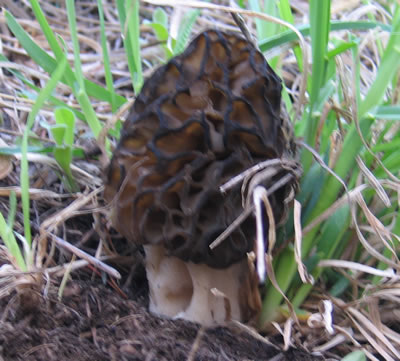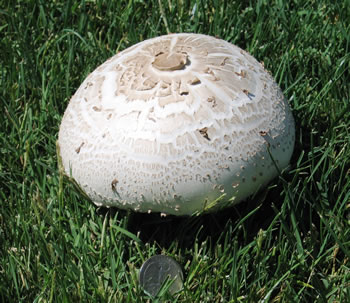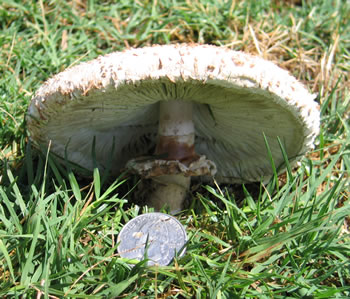Amanitas
As a mushroom hunter, you absolutely must familiarize yourself with the genus Amanita. Deadly Amanitas are the cause of the majority of mushroom poisoning deaths in the country. They grow large and the poisonous varieties often have a pleasant taste. They share some characters with the widely edible Agaricus, and some edible species of Amanita are collected by (very adventurous) mushroom hunters.
Other cultures, especially east Asian cultures, commonly collect Amanitas and their edible lookalike Volvariella (the paddy straw mushroom) in their home countries. Alas, poisonous North American Amanitas can resemble edible Asian varieties; you can guess the unfortunate results.
Amanitas are mycorrhizal; mostly with conifers. You will often find them in or at the edge of forests. While you may find Amanitas a stones throw away from the treeline, it is only because they are developing from the farthest reaches of the tree roots.
The key identifying features of Amanitas are:
- Long, straight stem
- Cap margin often striated
- Specialized base: typically bulbous and possibly scaly
-- Additionally at base, a sac called a volva is typically present
- Skirt connected at the top of the stem, typically present
- White spores on free gills (some species have colored gills)
- Almost always in the presence of conifers.
- Typically medium to large in size.
Please take a moment to page through an image search of the genus Amanita. Note the common characters of this stately mushroom. On your walks during mushroom season, try to find Amanitas and learn their appearance.
MushroomExpert.com has an excellent summary of Amanita characteristics and an identification key to some common species.
- The Western Destroying Angel (Amanita ocreata )
As a very general rule, any all-white mushroom should be looked at as suspect. Seasoned mushroomers will scoff at this, but such a guideline helps keep amateur foragers safe from this deadly Amanita.
Michael Kuo at MushroomExpert.com summarizes the destroying angel well:
The distinguishing features of [Amanita ocreata] are:
- The white "sack" around the base, known as a " volva ," resulting from the universal veil .
- The pure white gills, which are usually free from the stem.
- The stark white color of the entire mushroom.
- The smooth cap, which almost always lacks patches or warts.
Please refer to your mushroom ID guide and review the characters of this deadly Amanita. Details are also listed at MushroomExpert.com.
Amanita ocreata definitely occurs in Arizona. It is listed in the Arizona Mycota Project fungi of Arizona checklist, and I have encountered it in the southeast sky islands of Arizona.
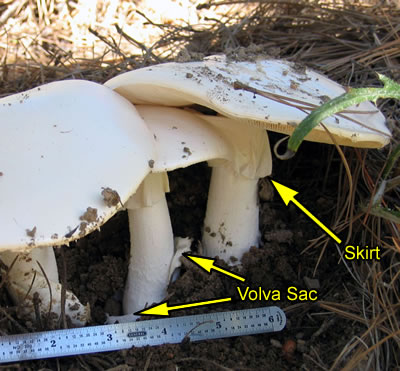
Amanita ocreata from Mt. Lemmon. This photo has a yellow tinge, but the mushrooms were pure white.
- The Death Cap (Amanita phalloides)
The death cap is another deadly Amanita that occurs in Arizona. Unlike the destroying angel, this Amanita has a colored cap. In other ways, it is similar in size and appearance.
These are the main characters of the death cap:
- Volva sac is present
- Skirt is present
- Cap ranges in color. Typically greenish / olive.
- Cap margin lacks striation
- White gills, free from stem
- Stem is fairly thick and straight
- White sporeprint
- May be found with oaks.
For a more detailed description, check your field guide or visit the Amanita phalloides page at MushroomExpert.com.
Amanita phalloides definitely occurs in Arizona. It is listed in the Arizona Mycota Project fungi of Arizona checklist.
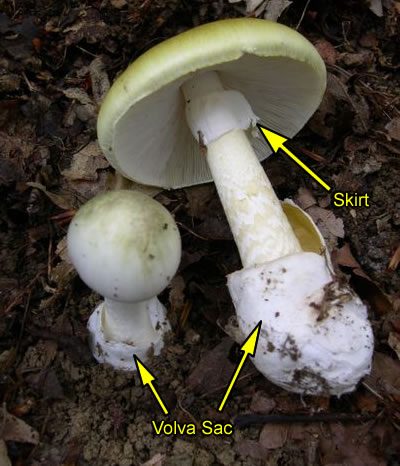
Amanita phalloides
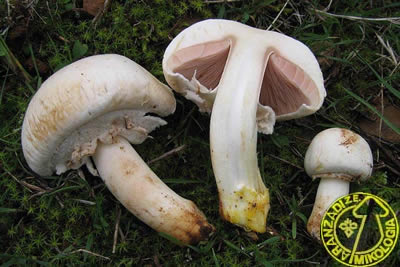
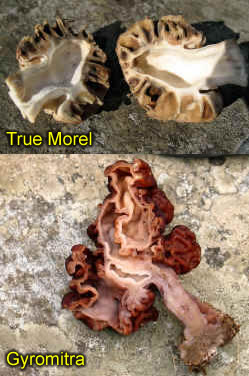 A good check to determine wether you have a true morel is to slice the mushroom in half. True morels have a hollow stem that is uninterrupted from top to bottom. False morels have solid stems and / or interrupted hollow cavities. Note the example here and see the difference.
A good check to determine wether you have a true morel is to slice the mushroom in half. True morels have a hollow stem that is uninterrupted from top to bottom. False morels have solid stems and / or interrupted hollow cavities. Note the example here and see the difference. 